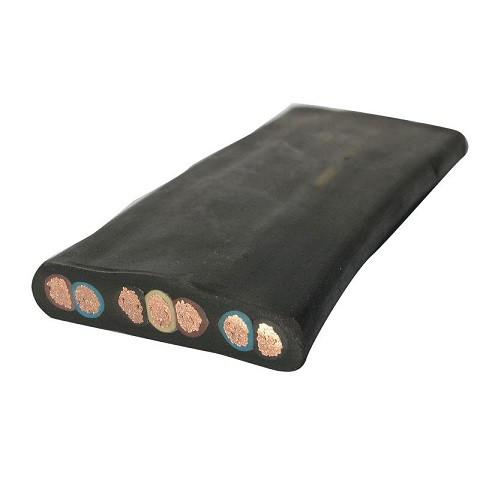Introduction to Variable Frequency Cables
Variable frequency cables are primarily used for connecting variable frequency power supplies and variable frequency motors, as well as for power transmission in distribution lines with a rated voltage of 1KV and below. They are especially suitable for industries such as papermaking, metallurgy, metal processing, mining, railways, and food processing.
Structure of Variable Frequency Cables
The structure of variable frequency cables includes three main insulated conductors and three neutral insulated conductors. An inner shielding layer, copper tape layer, outer shielding layer, and outer sheath layer are sequentially arranged outside the main insulated conductors and neutral insulated conductors, forming a 3+3 core structure. This design gives the cable strong voltage impact resistance, allowing it to withstand pulse voltages during high-speed and frequent frequency changes, providing good protection for variable frequency electrical devices.
Usage Conditions
1. Rated voltage U0/U: 0.6/1KV.
2. The long-term allowable high temperature for the cable conductor is 90 degrees, and the high temperature during short circuit is 250 degrees.
3. The installation and laying environment temperature should not be lower than 0 degrees; when fixedly laid, the environment temperature should not be lower than -10 degrees.
4. The minimum allowable bending radius of the cable should not be less than 15D (D - outer diameter of the cable, mm).
Product Performance
1. The design of the BRYJVP12R-TK and ZRBPYJVP12R-TK types adopts class 5 soft-stranded copper conductors in accordance with GB/T3956-1997.
2. Cross-linked polyethylene insulation with good temperature and weather resistance.
3. Low transmission impedance and good electromagnetic compatibility.
4. Low working capacitance.
5. Good anti-interference and low radiation performance.
6. Symmetrical three-core cable structure design that offers better transmission performance than four-core cables.
Variable Frequency Cable Model Names:
BPYJVTP2-TK: Copper core cross-linked polyethylene insulated PVC sheath cable with copper tape shield for variable frequency drive loop cable.
ZRBPYJVTP2-TK: Copper core cross-linked polyethylene insulated flame-retardant PVC sheath cable with copper tape shield for variable frequency drive loop cable.
BPYJVP12-TK: Copper core cross-linked polyethylene insulated PVC sheath cable with copper tape shield and copper wire braid double shielding for variable frequency drive loop cable.
ZRBPYJVP12-TK: Copper core cross-linked polyethylene insulated flame-retardant PVC sheath cable with copper tape shield and copper wire braid double shielding for variable frequency drive loop cable.
BPYJVPX12R-TK: Copper core cross-linked polyethylene insulated PVC sheath cable with copper tape shield and tinned copper wire braid double shielding for variable frequency drive loop cable.
ZRBPYJVPX12R-TK: Copper core cross-linked polyethylene insulated flame-retardant PVC sheath cable with copper tape shield and tinned copper wire braid double shielding for variable frequency drive loop cable.
Range of Specifications for Variable Frequency Cables
Model | Number of Cores | Nominal Cross Section (MM)
BPYJVTP2-TK | 3 | 1.5~240
ZRBPYJVTP2-TK | 3 | 1.5~240
BPYJVP12R-TK | 3+3 | Main conductor cross section: 2.5-240, auxiliary conductor cross section: 0.5-35
BPYJVPX12R-TK | 3+3 | Main conductor cross section: 2.5-240, auxiliary conductor cross section: 0.5-35
ZRBPYJVP12R-TK | 3+3 | Main conductor cross section: 2.5-240, auxiliary conductor cross section: 0.5-35
ZRBPYJVPX12-TK | 3+3 | Main conductor cross section: 2.5-240, auxiliary conductor cross section: 0.5-35
Price of Variable Frequency Cables
The price of the cables varies depending on the model and specifications. To inquire about the price of the YJV22 armored power cable, please click on online consultation or call the toll-free hotline at 13891818668/15929561136 for communication. We will be ready to answer your questions! The above content is provided by Xi'an Huitong Wire and Cable http://www.xahtxl.com/.













